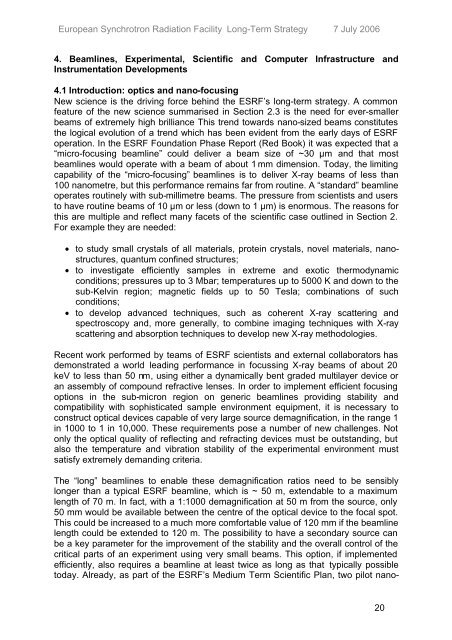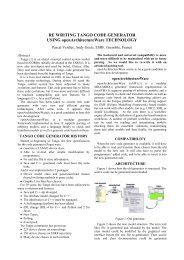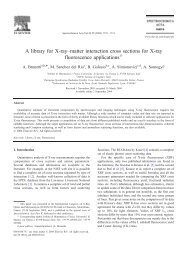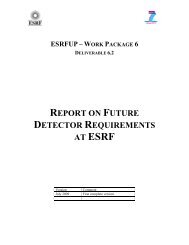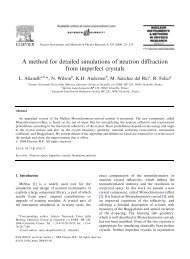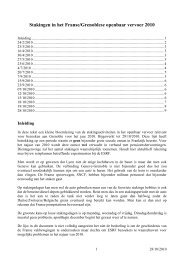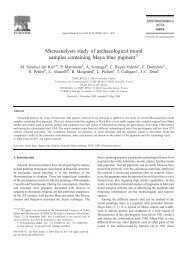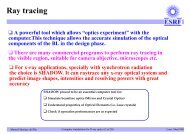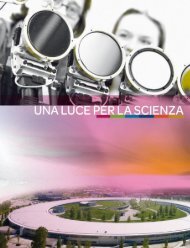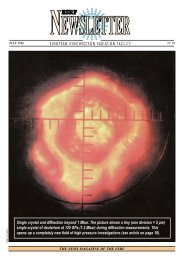New Scientific Opportunities at the European Synchrotron Radiation ...
New Scientific Opportunities at the European Synchrotron Radiation ...
New Scientific Opportunities at the European Synchrotron Radiation ...
Create successful ePaper yourself
Turn your PDF publications into a flip-book with our unique Google optimized e-Paper software.
<strong>European</strong> <strong>Synchrotron</strong> Radi<strong>at</strong>ion Facility Long-Term Str<strong>at</strong>egy 7 July 2006<br />
4. Beamlines, Experimental, <strong>Scientific</strong> and Computer Infrastructure and<br />
Instrument<strong>at</strong>ion Developments<br />
4.1 Introduction: optics and nano-focusing<br />
<strong>New</strong> science is <strong>the</strong> driving force behind <strong>the</strong> ESRF’s long-term str<strong>at</strong>egy. A common<br />
fe<strong>at</strong>ure of <strong>the</strong> new science summarised in Section 2.3 is <strong>the</strong> need for ever-smaller<br />
beams of extremely high brilliance This trend towards nano-sized beams constitutes<br />
<strong>the</strong> logical evolution of a trend which has been evident from <strong>the</strong> early days of ESRF<br />
oper<strong>at</strong>ion. In <strong>the</strong> ESRF Found<strong>at</strong>ion Phase Report (Red Book) it was expected th<strong>at</strong> a<br />
“micro-focusing beamline” could deliver a beam size of ~30 µm and th<strong>at</strong> most<br />
beamlines would oper<strong>at</strong>e with a beam of about 1 mm dimension. Today, <strong>the</strong> limiting<br />
capability of <strong>the</strong> “micro-focusing” beamlines is to deliver X-ray beams of less than<br />
100 nanometre, but this performance remains far from routine. A “standard” beamline<br />
oper<strong>at</strong>es routinely with sub-millimetre beams. The pressure from scientists and users<br />
to have routine beams of 10 µm or less (down to 1 µm) is enormous. The reasons for<br />
this are multiple and reflect many facets of <strong>the</strong> scientific case outlined in Section 2.<br />
For example <strong>the</strong>y are needed:<br />
• to study small crystals of all m<strong>at</strong>erials, protein crystals, novel m<strong>at</strong>erials, nanostructures,<br />
quantum confined structures;<br />
• to investig<strong>at</strong>e efficiently samples in extreme and exotic <strong>the</strong>rmodynamic<br />
conditions; pressures up to 3 Mbar; temper<strong>at</strong>ures up to 5000 K and down to <strong>the</strong><br />
sub-Kelvin region; magnetic fields up to 50 Tesla; combin<strong>at</strong>ions of such<br />
conditions;<br />
• to develop advanced techniques, such as coherent X-ray sc<strong>at</strong>tering and<br />
spectroscopy and, more generally, to combine imaging techniques with X-ray<br />
sc<strong>at</strong>tering and absorption techniques to develop new X-ray methodologies.<br />
Recent work performed by teams of ESRF scientists and external collabor<strong>at</strong>ors has<br />
demonstr<strong>at</strong>ed a world leading performance in focussing X-ray beams of about 20<br />
keV to less than 50 nm, using ei<strong>the</strong>r a dynamically bent graded multilayer device or<br />
an assembly of compound refractive lenses. In order to implement efficient focusing<br />
options in <strong>the</strong> sub-micron region on generic beamlines providing stability and<br />
comp<strong>at</strong>ibility with sophistic<strong>at</strong>ed sample environment equipment, it is necessary to<br />
construct optical devices capable of very large source demagnific<strong>at</strong>ion, in <strong>the</strong> range 1<br />
in 1000 to 1 in 10,000. These requirements pose a number of new challenges. Not<br />
only <strong>the</strong> optical quality of reflecting and refracting devices must be outstanding, but<br />
also <strong>the</strong> temper<strong>at</strong>ure and vibr<strong>at</strong>ion stability of <strong>the</strong> experimental environment must<br />
s<strong>at</strong>isfy extremely demanding criteria.<br />
The “long” beamlines to enable <strong>the</strong>se demagnific<strong>at</strong>ion r<strong>at</strong>ios need to be sensibly<br />
longer than a typical ESRF beamline, which is ~ 50 m, extendable to a maximum<br />
length of 70 m. In fact, with a 1:1000 demagnific<strong>at</strong>ion <strong>at</strong> 50 m from <strong>the</strong> source, only<br />
50 mm would be available between <strong>the</strong> centre of <strong>the</strong> optical device to <strong>the</strong> focal spot.<br />
This could be increased to a much more comfortable value of 120 mm if <strong>the</strong> beamline<br />
length could be extended to 120 m. The possibility to have a secondary source can<br />
be a key parameter for <strong>the</strong> improvement of <strong>the</strong> stability and <strong>the</strong> overall control of <strong>the</strong><br />
critical parts of an experiment using very small beams. This option, if implemented<br />
efficiently, also requires a beamline <strong>at</strong> least twice as long as th<strong>at</strong> typically possible<br />
today. Already, as part of <strong>the</strong> ESRF’s Medium Term <strong>Scientific</strong> Plan, two pilot nano-<br />
20


